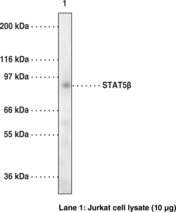Antigen:
synthetic peptide corresponding to amino acids 771-787 of human STAT5β
·
Host:
rabbit
·
Application(s):
WB
·
Signal Transducers and Activators of Transcriptions (STATs) are a family of cytoplasmic latent transcription factors that are activated to regulate gene expression in response to a large number of extracellular signaling polypeptides including cytokines, interferons, and growth factors.1,2,3 After phosphorylation by JAK tyrosine kinases, STATs enter the nucleus to regulate transcription of many different genes. Among the seven STATs (STAT1, STAT2, STAT3, STAT4, STAT5α, STAT5β, and STAT6), STAT1, STAT3, STAT5α, and Stat5β have a wide activation profile. Both STAT5α and STAT5β regulate interleukin-7 induced B-cell precursor expansion.4 STAT5β may also act as a transcriptional inhibitor as demonstrated by inhibition of NF-κB mediated signaling.5 This STAT5β-mediated inhibitory effect on NF-κB signaling does not depend on STAT5β-DNA interactions but requires the carboxyl terminus of STAT5β as well as STAT5β nuclear translocation and/or accumulation, suggesting that STAT5β is competing for a nuclear factor(s) necessary for NF-κB-mediated activation of target promoters.
1
Leonard, W.J., and O'Shea, J.J. JAKS AND STATS: Biological implications. Annu Rev Immunol 16 293-322 (1998).
2
Schindler, C., and Darnell, J.E. Transcriptional responses to polypeptide ligands: The JAK-STAT pathway. Annu Rev Biochem 64 621-562 (2011).
3
Darnell, J.E. STATs and gene regulation. Science 277 1630-1635 (1997).
4
Sexl, V., Piekorz, R., Moriggl, R., et al. Stata/b contribute to interleukin 7-induced B-cell precursor expansion, but abI- and bcr/abI-induced transformation are independent of Stat5. Blood 96 2277-83 (2000).
5
Luo, G., and Yu-Lee, L. Stat5b inhibits NFκB-mediated signaling. Mol Endocrinol 14 114-23 (2000).






